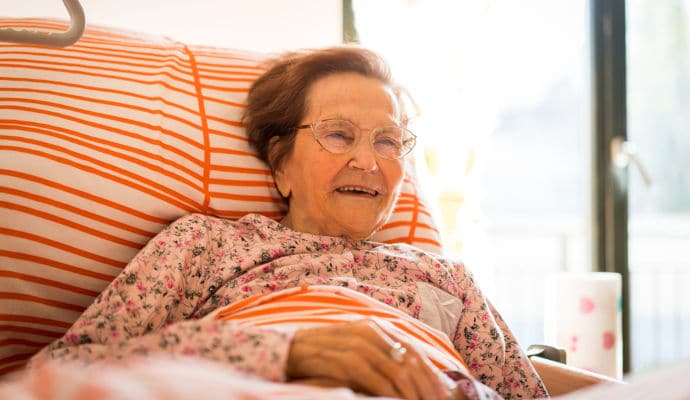
Seniors with limited mobility are at serious risk for bed sores (pressure sores). Spending a significant amount of time sitting or lying down without changing position can lead to these potentially life-threatening wounds. Vive Health explains why bed sores are so deadly, causes, stages, and how to detect them before serious damage is done.
If you are caring for an older adult who has limited mobility or is confined to a bed, recliner, or wheelchair, knowing your way around bed sores is a must.
Why?
While seemingly harmless in the beginning, bed sores can quickly progress into life-threatening tissue decay and infection.
It may sound dramatic, but whisper concerns about a bed sore to any medical professional and they’ll probably have a wound care specialist evaluating your older adult STAT.
Unfortunately, the people most susceptible to developing bed sores are the ones already experiencing debilitating illnesses which have cost them their mobility in the first place.
Find out what a bed sore is, what causes them, the 4 stages of bed sore severity, and how to spot one before it turns into a serious wound.
What is a bed sore?
Bed sores, also known as pressure sores or pressure ulcers, are open wounds on the body where skin and tissue are breaking down because of prolonged pressure from bones.
When someone spends most of their time lying or sitting in the same position, the bony protrusions of the body place pressure on internal tissues.
Over time, this cuts off blood circulation and leads to tissue damage and skin breakdown.
Common bed sore locations include:
- Shoulder blades
- Tailbone
- Hips
- Elbows
- Heels
What causes bed sores? 7 contributing factors
1. Lack of movement
Advanced age or serious health conditions can reduce your older adult’s ability to move. And, if they’re also affected by paralysis, coma, sedation, or injury, that will force them to lie down or sit for long periods of time.
This significantly increases the risk of developing bed sores.
2. Older age
As we age, our skin becomes thinner and less elastic. The loss in skin strength makes older adults who spend most hours sitting or lying down more vulnerable to sores.
3. Poor nutrition
Essential vitamins and minerals play a critical role in keeping skin and tissues strong. Those include protein, vitamin C, zinc, calcium, and potassium.
If your older adult’s diet is missing whole foods that aid tissue repair and support blood circulation, they could be at higher risk for skin breakdown and bed sores.
4. Being underweight
Many patients with chronic illness especially may be underweight because of loss of appetite, dysphagia (difficulty swallowing), or medication side effects.
Unfortunately, the less fat and padding there is on the body, the less able it is to protect against pressure from bony protrusions and the more likely they are to develop a bed sore.
5. Smoking
Smoking leads to heart disease and cancer and it also increases risk for bed sores.
That’s because it narrows blood vessels, which decreases circulation. Then, vulnerable tissues don’t receive the oxygen and nutrients they need from the poorly circulating blood.
6. Incontinence
Contact with urine and feces from incontinence can make the tail bone and even hip areas more susceptible to skin breakdown.
The skin will be more easily broken and in close contact with bacteria.
7. Cognitive impairment
If your older adult has Alzheimer’s disease, dementia, or other cognitive decline that affects their ability to communicate, they may have difficulty alerting you to or describing pain from a developing bed sore.
4 bed sore stages: slight to life-threatening
There are four main stages of bed sores which range from initial warning signs to life-threatening tissue decay.
Stage I
Slight to significant redness and discoloration of the skin at a bony pressure point is the first warning sign that a bed sore is developing.
To test for a potential bed sore, find out if the area “blanches.” If it does, the tissue hasn’t been damaged yet.
To test, lightly press the spot with your finger. If it goes white and then flushes red again, it is successfully blanching. Try it on yourself to see what the non-damaged reaction looks like.
Stage II
Left unmonitored and untreated, a bed sore will progress to where the skin breaks open and the beginnings of an ulcer form. The area will feel tender and painful to your older adult.
Stage III
A stage III bed sore forms a deep crater through skin and layers of tissue to the subcutaneous fat underneath. The less blood flow the area gets, the more tissue that decays.
Stage IV
In the final stage, a bed sore has progressed so far that the ulcerous crater goes all the way down through the soft tissue to show bone.
This massive breakdown and decay is at extremely high risk for infection and is a life-threatening condition.
How to detect a bed sore
Paying attention to your older adult’s body helps you prevent bed sores or spot them early.
Every day, scan their body and double check the bonier parts for discolorations. Do the blanch test on any suspicious areas. Ask your older adult if they have pain or discomfort anywhere.
Common signs of developing bed sores:
- Unusual changes in skin color or texture
- Swelling
- Pus-like draining
- Skin that feels cooler or warmer to the touch than other areas
- Tender areas
What to do if you suspect a bed sore
If you’re worried about a potential bed sore, have your older adult get a medical exam right away – sores can develop and worsen significantly within days.
Recommended for you:
- 6 Hygiene Tips for Bed Bound Seniors
- Incontinence Care: 9 Tips for Caregivers
- 10 Common Chronic Diseases in Seniors: How to Prevent and Manage
Guest contributor: Jessica Hegg is the content manager at ViveHealth.com. Interested in all things related to living healthy lifestyle, she works to share valuable information aimed at overcoming obstacles and improving the quality of life for others.
This article wasn’t sponsored and doesn’t contain affiliate links. For more information, see How We Make Money.




